
As the day goes on, more salespeople dump more cold emails into my inbox. And like clockwork, I delete nearly all of them—most of those without even reading them. The ones I do read tend to be exactly what I expected: a salesperson who didn’t really do their research and shouldn’t be reaching out to me.
Sometimes the emails are too long, sometimes they’re too short. Sometimes I have no idea what they’re about or what action the sender wants me to take. Sometimes I’m pretty sure the sender doesn’t even know who I am. On a very rare occasion, I come across a cold email that I actually read, find useful, and respond to. And sometimes (less rarely), I am actually surprised by the sheer awfulness of the email.
Over the years, I’ve had some stupendously bad cold emails invade my inbox. In fact, sharing the worst of the worst has become something of an office sport among my colleagues. And now, I’ve decided to compile a cold email Hall of Shame so that we can all learn from past mistakes and get better at this critical form of sales communication.
Now, before we start with the list of bad email examples, let’s lay out what a good cold email should do so that we’re all on the same page.
That said, here’s a link if you need to study more best practices.
To prevent eye-strain, click any of the emails to see full-size versions, and please note that I have blacked out all personal information for the protection of both the senders and receivers of these bad email examples.

My colleague received this email from someone we hope is a well-intentioned though misguided sales rep, but who actually comes off as a potential stalker targeting female office workers.


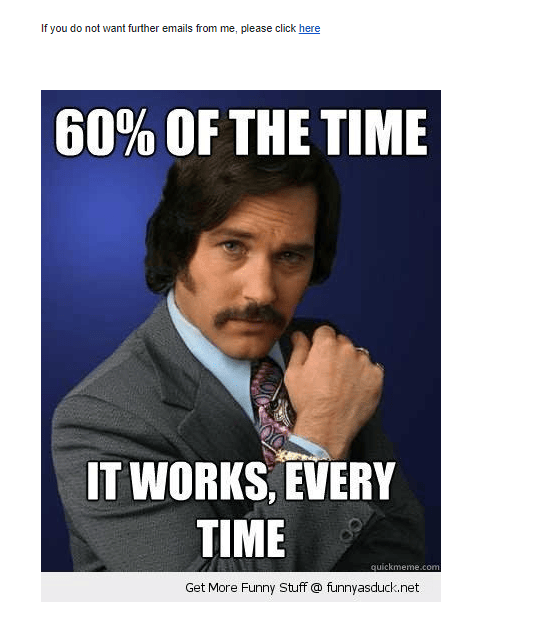
You should probably make sure that you are sending flawless cold emails before you start calling yourself “The Colossus of Cold Email,” otherwise you might end up on this list.
This sender went on to send my colleague at least three more cold emails, each somehow worse than the first. One email is more or less just a meme with no CTA. I’ll go ahead and share some of my favorites below. Behold the terrible punctuation, sad formatting, and multiple cat memes. Or as the Colossus himself would put it, “Scroll Down for a Rad Experience!!!”
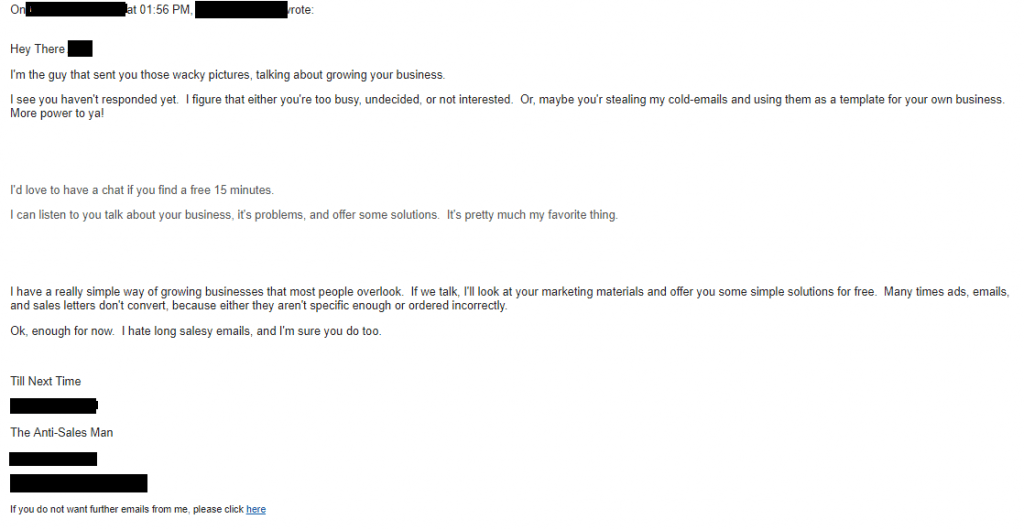
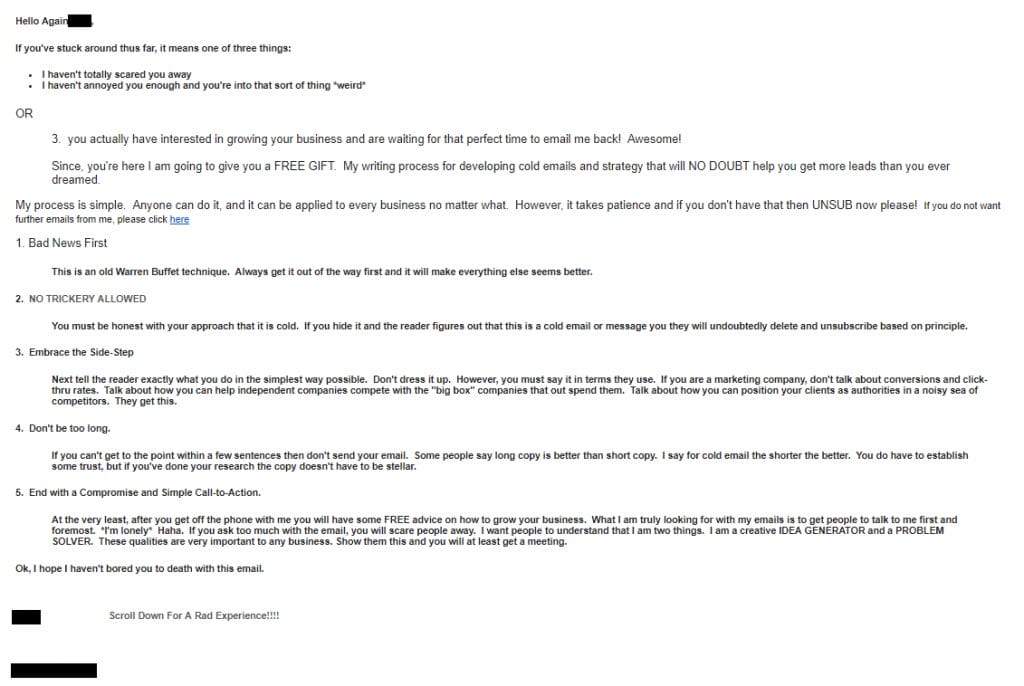

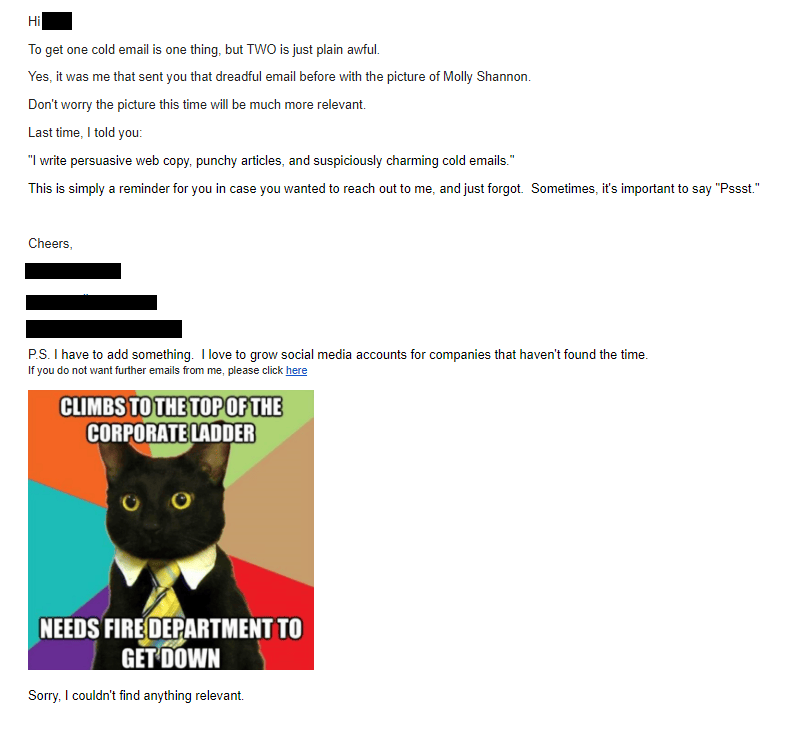

My colleague recently received this charmer apparently sent during a Walking Dead episode.


This email is actually one in a series of emails (all of which I will share with you), and is so bad that a friend of mine from a different company independently forwarded this same email to me without knowing that I was already including it from my own inbox.
Anyhow, enjoy a few more terrible emails from Raquel, including one that contains the phrase “I lied,” which is always comforting to hear from salespeople.
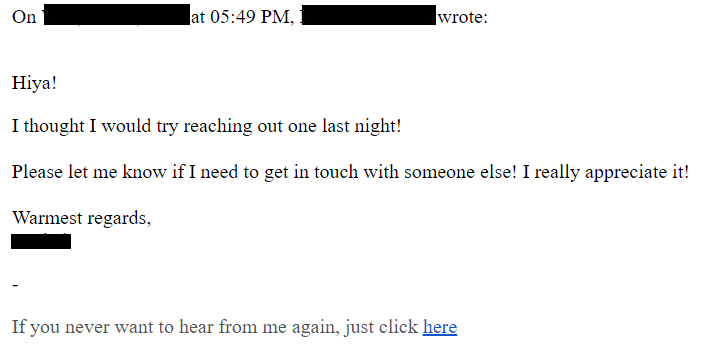

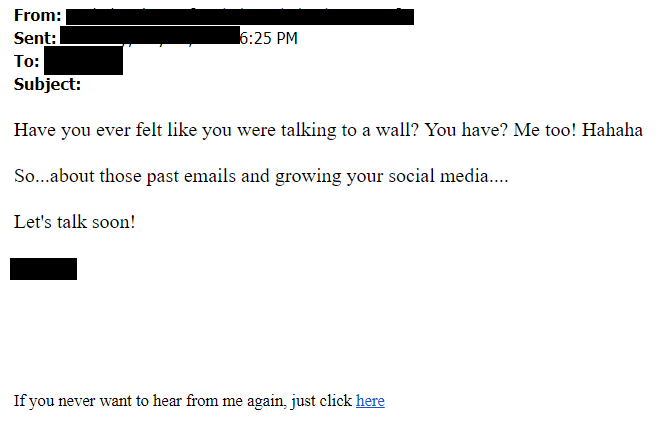
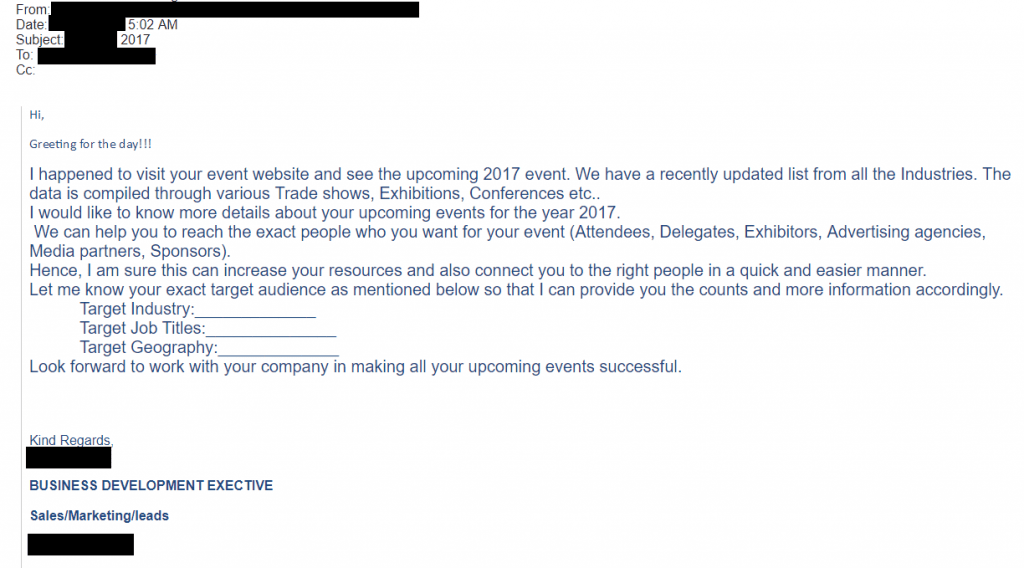
My colleague forwarded this to me, mentioning that he felt bad for sending this to me because it’s clearly from someone whose second language is English, but he just had to pass it along because he received two of these at the same time from two different people. I don’t feel bad for including this email on this list, though, for a number of reasons.
All of these cold emails are truly dreadful. To avoid joining their ranks, be sure that you’re sending out simple emails with clear CTAs, and that you’re doing your research on prospects before contacting them. Sales is a numbers game, sure, but it’s first and foremost a quality game.
I asked the Nutshell team if they had any terrible cold emails to share for this article, and they had some doozies. Here are a couple of my favorites, presented with their anonymous commentary.
“After a couple of bland, forgettable contact attempts—work on that subject line, buddy—the sender of these emails began to unravel before my eyes.”

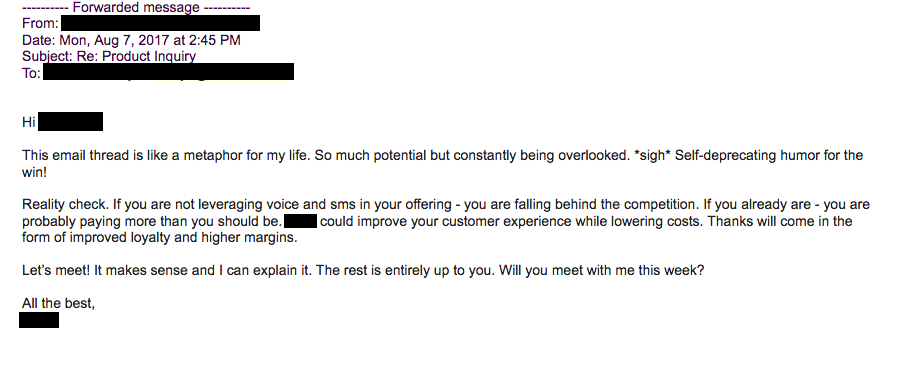
“If the point of these emails was to make me feel bad for him, then mission accomplished. Unfortunately, I still have no interest in doing business with him or his company. Self-deprecating humor for the loss, actually.”

“This one totally infuriated me. First off, the guy tricked me into opening his email by invoking our CEO’s name in the subject line. (That ‘What time on Tuesday works best?’ line was also annoyingly presumptuous, considering we had never connected before and he didn’t know my availability.) And when I didn’t reply to him, he basically threatened to tell on me to my boss.”


“I considered writing back with, ‘I would never work with you in a million years, a**hole,’ but I’m going to be the bigger person and just ignore him forever.”
This was forwarded to me by a colleague, and I couldn’t help but include it on this list.
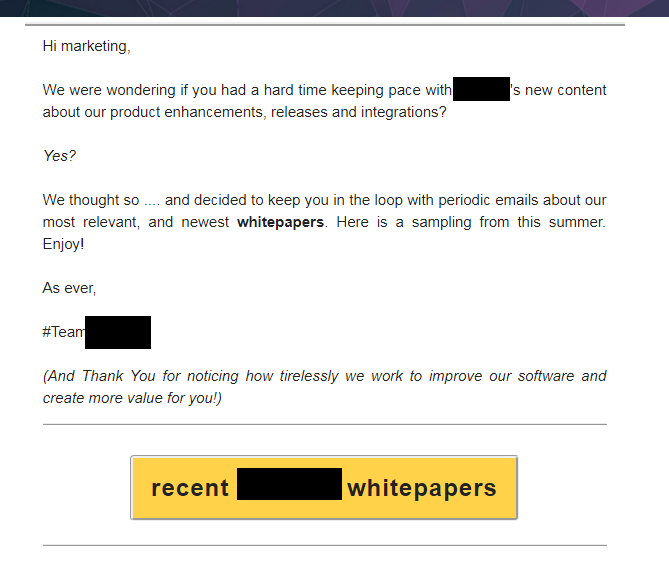


“I’ve never had a newsletter make me visibly shake before, but there’s a first time for everything.”
Got any horrible cold emails rotting in your inbox? Forward the worst one to growth@nutshell.com. Your anonymity will be guaranteed.
The average cold email response rate is around 8.5%, but top performers consistently achieve 15-40% by focusing on personalization and relevance. If you’re getting less than 8%, it’s time to revisit your targeting and messaging. Remember, quality beats quantity—a well-researched email to the right person will always outperform a generic blast to hundreds.
Send 3-4 follow-up emails over a two-week period. Research shows that 70% of responses come from the 2nd to 4th email in a sequence, so don’t give up after one try. Space them out (2-3 days between the first two, then 4-5 days after), and make sure each follow-up adds value rather than just saying “checking in.”
Tuesday through Thursday between 1-3 PM typically sees the highest engagement. People are settled into their workweek and looking for a productive distraction after lunch. That said, test different times for your specific audience—a CEO might check email at 6 AM, while a creative professional might be more responsive in the afternoon.
Yes, the CAN-SPAM Act requires you to provide an easy opt-out option in commercial emails. For cold emails, skip the formal “unsubscribe” button and use conversational language like “P.S. Not interested? Just reply and let me know.” This keeps your email personal while staying compliant and respecting your recipient’s inbox.
Keep your emails simple and authentic. Avoid spam trigger words like “free,” “guarantee,” or excessive punctuation. Set up proper email authentication (SPF, DKIM, and DMARC records), warm up new domains gradually, and limit links to 1-2 per email. Most importantly, send relevant, personalized messages to people who actually fit your target audience—spam filters are smart enough to detect mass, generic emails.
Learn the email tactics that B2B sales pros use to hook their customers.
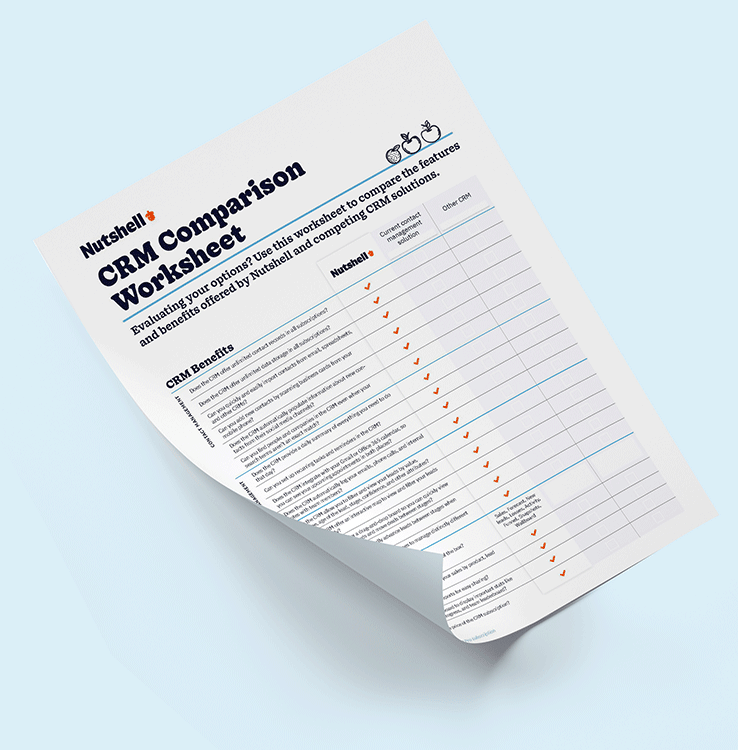
Join 30,000+ other sales and marketing professionals. Subscribe to our Sell to Win newsletter!
